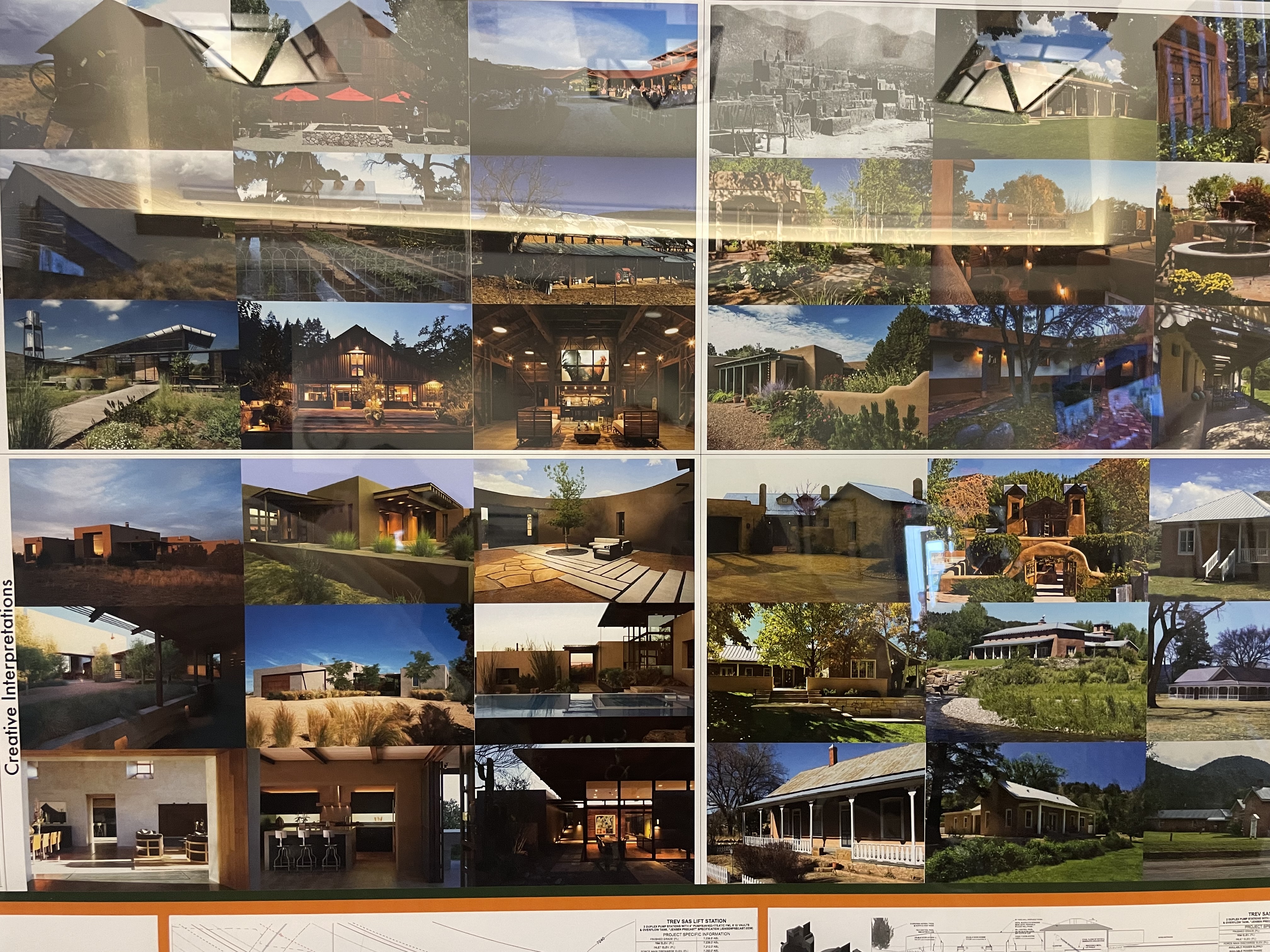By KAY MATTHEWS
The people who packed into the Taos County Commission chamber on Tuesday, June 11, waiting for their 3-minue turn to comment on the Tarleton Ranch Eco-Village (TREV) development, were none too happy when the county manager made those who weren’t seated move outside while the hearing commenced (due to safety overload). The developers of the project, of course, were first in line to make their presentations to the commissioners, on the Planned Unit Development (PUD) and Type II Preliminary Plat Subdivision Application. Those of us who were able to stay inside could hear drumming from the outside crowd as they waited to present their overwhelming opposition to TREV in the afternoon.
Taos County Planner Rudy Perea gave a brief overview of TREV: 331.43 acres with a division into 413 lot-sites ranging from .0574 to 11 acres in size. He claimed that the project doesn’t technically require a zone change—it falls under the 2003 Upper Las Colonias Neighborhood Zone Regulations, which overlay the Taos County Land-Use Regulations, with a “relaxation of performance standards.” The area will be developed in four phases with a set aside of 100 acres for recreation and agricultural use.
The presentations by the those involved in the development—attorney Karl Sommer, owner Mike Tarleton, developer Mark Yaravitz, and master planner John Halley—all made the argument that if the county doesn’t approve TREV other forces will descend upon Taos and sell off not only the 300-acre Tarleton Ranch but all the county’s remaining rural ranchland. In other words, the rationale that’s often used to frighten the opposition with the threat that if I don’t get my way someone much worse than me is going to come along and get his or her way.
El Prado Water and Sanitation board member John Painter relied on this rationale to defend the sale of the district’s 200-acre feet per year (afy) to TREV as opposed to the potential two to three hundred individual wells that could be drilled on the property. Under Painter’s guidance, El Prado increased its water allotment under the Abeyta, or Taos Pueblo Water Rights Settlement, from 25 to 575 afy to underwrite future development along the northern Taos corridor. At the hearing he claimed that the district’s two new deep wells on SH 64, Midway numbers 5 and 6, won’t supply TREV but only its existing customers. In 2017 TREV asked El Prado if it had enough water to serve the development and the district committed 200 afy with a “rotation of supply between the El Torreon and Upper Las Colonias wells.” The district currently pumps 94-96 afy (it built up a water debt to the Office of the State Engineer).

The morning session gave the public somewhat of a window into where the commissioners might stand on the issue through their questions. District III Commissioner Darlene Vigil asked Painter if TREV falls within the boundary of El Prado—it will have to petition to be included, with a public hearing—and if the developers had consulted with the commissioners of the Upper/Lower Acequia de Manuel Andres Trujillo, the acequia that Tarleton has water rights on. Commissioner John Jacobs came to the podium to state that the acequia had signed a “letter of understanding” with TREV to ensure that the commissioners will be notified on the progress of the applications—PUD, operations, improvements, etc.— and each parcel of land sold will be reported. District IV Commissioner AnJanette Brush asked Jacobs if the parciantes on his ditch were comfortable with this arrangement, and he responded that while the acequia should have been notified earlier of the planned development, they will work with the developers in a “spirit of cooperation” to avoid any sale of acequia water rights. District I Commissioner F. R. Bob Romero asked about the number of water rights within the development and Mike Tarleton responded that his family owns the water rights and he will retain ownership of those rights once TREV is approved.
Vigil also asked about the potential transfer of farm lands and Tarleton stated that they would remain within TREV. This brought up a series of questions regarding just who will actually be doing the farming and living in the development. Planner Halley clarified that the developers are “providing” the opportunity to farm with infrastructure such as a greenhouse. Vigil pointed out that the proposal states that approximately 10 percent of the housing will be “low income” and then referenced a letter the commission received from Homewise, an agency that helps prospective buyers with workshops and affordable mortgages, stating that it had not agreed to work with TREV, as the developers claimed in their proposal. Yaravitz responded that Homewise failed to respond to TREV’s proposed collaboration and that they are working with other agencies and that planning small lots with infrastructure “is tricky.” Brush then said, “I would think that to actually have a housing plan would be at the top of the list.”

The discussion then turned to the definition of “work force housing” as opposed to “low income housing” when Bob Romero asked what guarantees the county has that there will be work force housing for locals. Yaravitz presented a long recitation on how TREV is trying to provide a wide range of housing for the Taos community with the work force model. He cited that the HUD (Housing and Urban Development) Average Median Income is $74,000 and that “we have no housing supply for that in Taos.” A range in price from $300,000 to $350,000 with a variety of styles is what TREV is offering. These would be smaller lots with full utilities that meet a work force or middle class population, not low income. TREV can only provide the model, not the actual production, which will depend on the market.

Commissioner Vigil got a round of applause when she stated that the county has been working on how to provide more housing for the local community and that nothing in TREV’s presentation indicates that it will serve that purpose. Attorney Sommers tried to fault the county, not the developers, because of the lack of county ordinances, and Yaravitz stated that the county could impose deed restrictions on work force housing that require a purchaser live in the county. He claimed that TREV could sell a 1,000 square two-bedroom house for $300,000 with help from agencies like Homewise.
County Manager Perea then stepped in to say that this hearing is to assess the PUD and housing questions are speculative. His assessment is that PUD meets the nine criteria required by a PUD. Yaravitz then read from the Taos County Comprehensive Plan to demonstrate that they are following the plan and were not asking for a housing density variance. There was a brief discussion of the traffic study that was conducted by the engineering consultant Timothy Simmons and reviewed by the New Mexico Department of Transportation. TREV will rely on either a round-about or traffic signal at Tarleton Road and SH 150 for ingress and egress, with widening of SH 150 to allow for turn lanes. Brush asked if the traffic study included the existing link between TREV and Taos Ski Valley, where traffic already congests during ski season. Simmons responded that there was no study conducted beyond the TREV boundaries.
Brush also asked how much engagement has been made with Taos Pueblo. This has been a question many have been asking as this process moves forward. Sommers told her that required notification was delivered to the Pueblo and Yaravitz made an obscure reference that he had had further discussions with someone at the Pueblo whom he wouldn’t name because of Pueblo politics. The issue of Pueblo politics quickly made its appearance during the public comments.

Towards the end of the morning session Taos Pueblo member Marie Tucker, aka Water Flower, sat next to me after drumming outside. I asked her what position, if any, the Pueblo is taking on TREV. Tucker, who doesn’t speak for the Pueblo, told me that she believes the Pueblo government, particularly Gilbert Suazo, will support the development because of its adherence to the Abeyta Settlement. But “the government doesn’t represent us,” she said. “Our people aren’t made aware of what goes on; there’s no communication between the government and the community. We need to support the Taos community and the environment. We like our sage.”
The afternoon heard testimony from other Taos Pueblo members who reiterated what Tucker told me in their opposition to the development: lack of communication and negative impacts on the environment, watershed, wildlife, culture, and sustainability. “We like the house we have.”
Other commenters brought up many of the same issues raised at the Planning Commission hearings: too big, too dense, incompatible with the surrounding community, water availability, no hydrological survey, exemptions to the Land Use Plan (that the developers call “relaxations”), traffic safety concerns on SH 150, impact on small businesses in Taos, noise pollution, non compliance with zoning (can PUD get relief from the underlying zoning ordinance), protection of dark skies, and lack of accountability. One woman requested that the developers set up an active oversight committee to provide that accountability. Another suggested taking the development to Taos County for a referendum vote. One speaker told the commissioners, “You are our gate keepers” who need to slow this down.
Several people spoke in favor of the development, including a Tarleton relative, a friend and colleague of Yaravitz, and a local Hispano, who emphasized the need for affordable housing to keep Taos youth from moving away. The meeting ended with County Planner Rudy Perea recommending that the PUD be approved because the subdivision criteria have been met. Commissioner Bob Romero made a motion for a continuance of deliberation on both applications until the second regular commission meeting in July, which was passed unanimously.



Thank you Kay for this in depth report, which gives a much more accurate overview of the June 11 County Commission meeting than the Taos News did last week!
Great coverage of Tarleton, Kay. Thanks for your continuing interest and telling it like it is.
Linda Fair